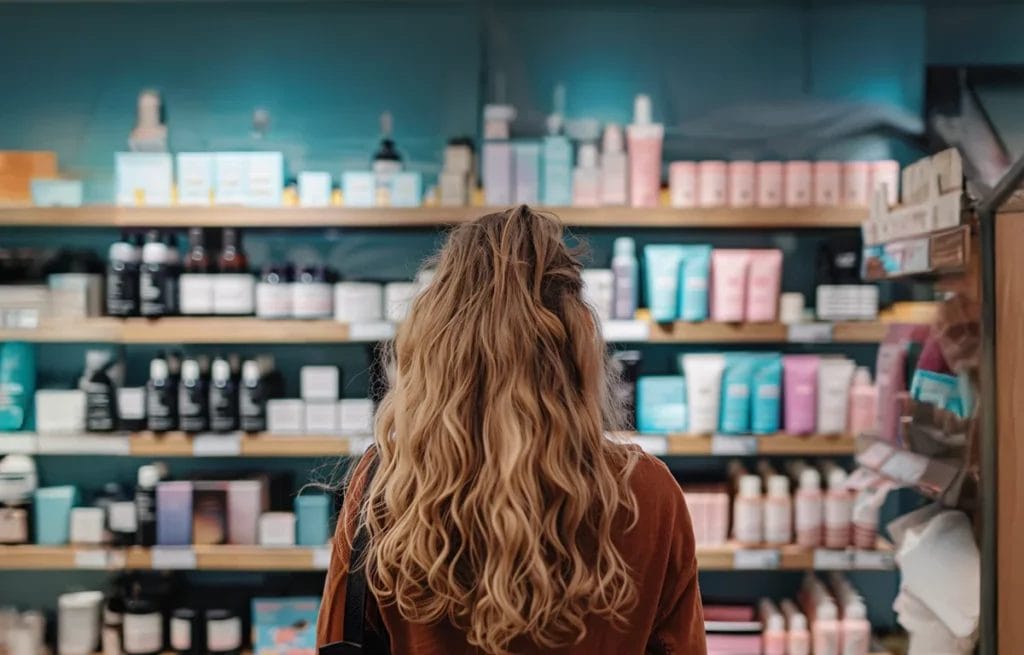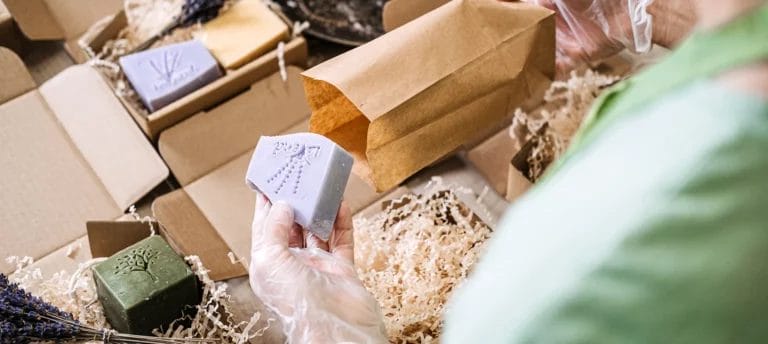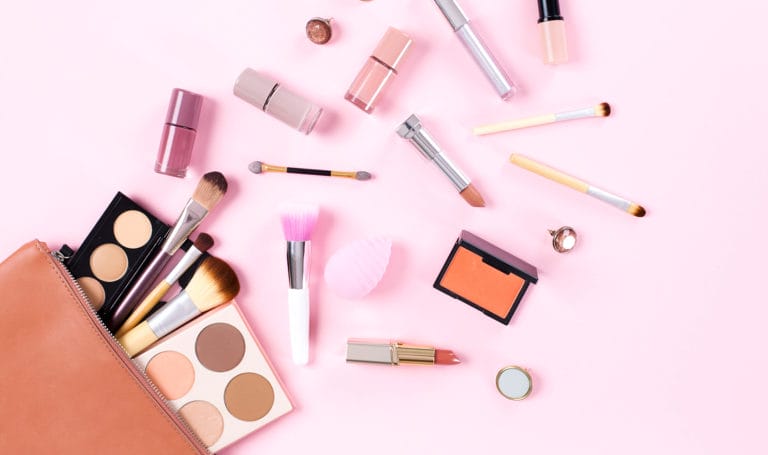- Last Updated:
- 6/19/2024
- Tricia Johnson
Starting a makeup line has plenty of glitz and glam, but a lot of work goes on behind the scenes to produce the bold brands and innovative products that make beauty fans rave. Makeup industry statistics tell the story of a competitive space with room for new brands to make their mark:
The cosmetic industry has grown almost non-stop since 2008 (even through a pandemic). It’s worth $129 billion in 2024. (Statista)
But with a makeup market saturated by 12% growth in e-commerce, it’s going to be harder for individual brands to stand out. (McKinsey)
Success and profit in cosmetics is do-able, but like any good makeup artist knows, achieving a flawless final result is all in priming and preparing your canvas. Some of the most important steps of how to start a cosmetic line involve managing your brand’s risks on the way to market.
Ready for a different kind of makeup tutorial?
How to Start a Makeup Line in 6 Steps (While Minimizing Risk)
Staying-power in the makeup business means getting good at managing your risks from concept to shelf. Let’s walk through major risks, coverage options, and helpful resources for every step of how to start a cosmetic line.
1. Develop Your Concept & Audience
When Sephora already sells 164 lipsticks, each in 3–30 shades, you need a customer in mind and a reason why they’d buy from you (and not just snag the new MAC red).
Makeup lines succeed when they identify a niche market — a group of customers united by a need. Your job is to match a market with a product that meets their need better than what’s in their makeup bag.
Ask yourself these questions to think through your product’s unique value to customers:
- Who is your product for? (If the answer is everyone, try again.)
- What are the needs of this audience? What’s their illusive holy grail product?
- Is this audience underserved or ignored by what’s already on the shelf?
- How is your product different or better than what’s available?
- If your product isn’t unique, is there something about your pricing, ingredients, branding, marketing, or business model different enough to get their attention?
- Does your product take advantage of any new or emerging trends? Do you have data (statistics, market research, client requests, sales, polls) that proves demand?
Many indie cosmetic brands start from the place of solving a customer problem within a specific niche market.
Niche Product Example:
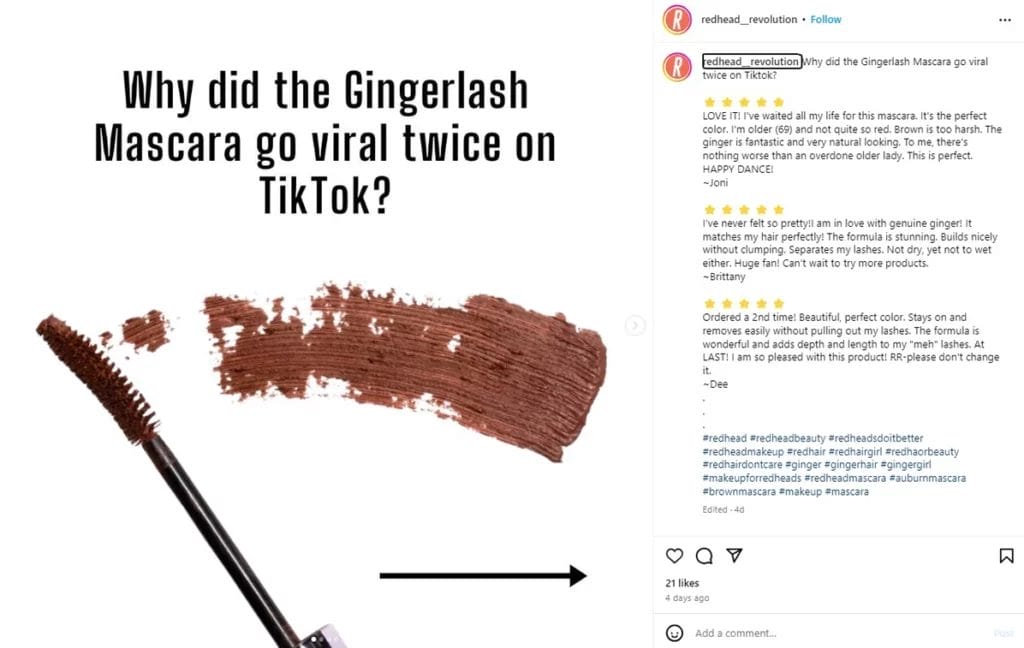
Problem: People with red hair have a hard time finding shades that look natural and don’t clash. They might also appreciate a little SPF in their complexion products, please and thank you.
Solution: Redhead Revolution founder Katelin Loveless started making the TikTok-famous Gingerlash Mascara for herself in her kitchen. The brand’s line of shades and products designed for redheads addresses a frustration for an underserved community. A need for 2% of the population is still a need – and 2% of the $129 billion cosmetic market is a massive number.
Niche: Makeup users with red hair and/or fair and freckled complexions who want to celebrate, not hide, what makes their beauty unique.
Niche Product Example:
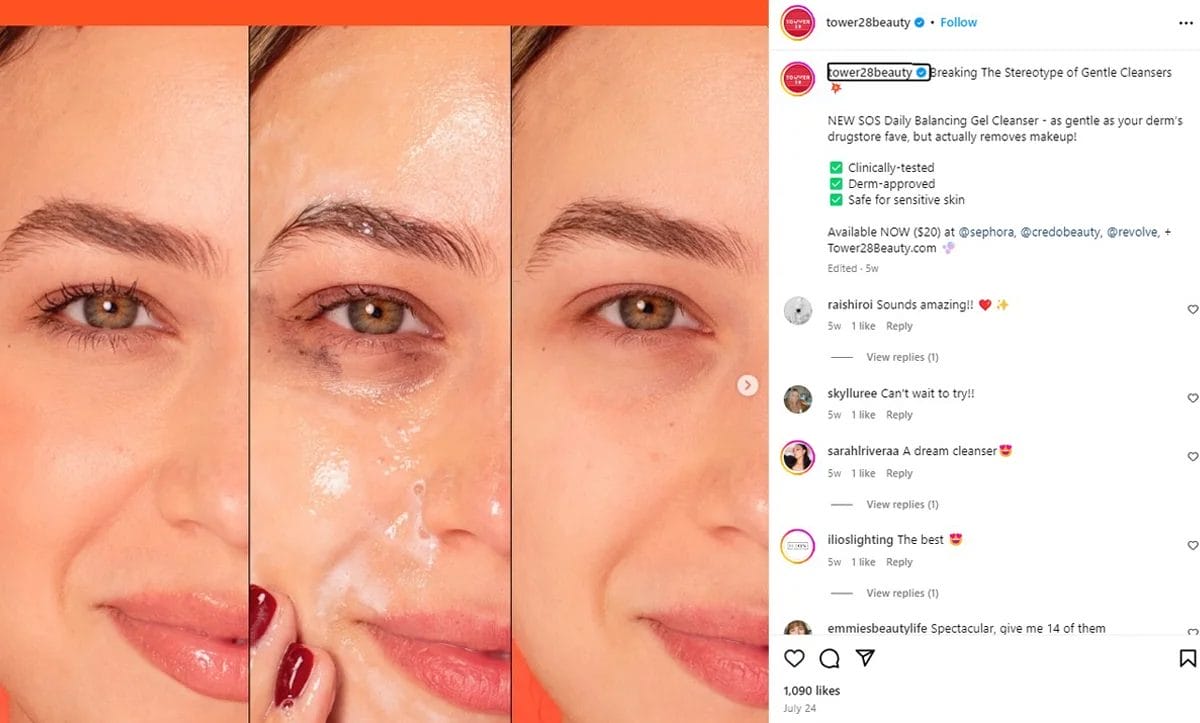
Problem: Makeup fans with sensitive skin have limited choices that won’t cause irritation while actually being strong enough to work. Most sensitive skin options lean towards clinical rather than playful, and finding makeup that works with their skin is still hit-and-miss.
Solution: Tower 28 Beauty started with founder Amy Liu’s struggle with eczema and the limited (and mostly boring) options out there for sensitive skin. The brand creates fun and playful products with clean, non-irritating ingredients.
Niche: Sensitive skin sufferers who want adventurous makeup options that still make their skin look and feel great.
What Are the Risks?
Market Misalignment
If you try to sell to the wrong audience or create makeup without a clear idea of who it’s for, what’s unique about it, or why you’re making it, you’re likely to over-forecast sales and end up buried in a sea of similar competitors.
Risk Case Study:
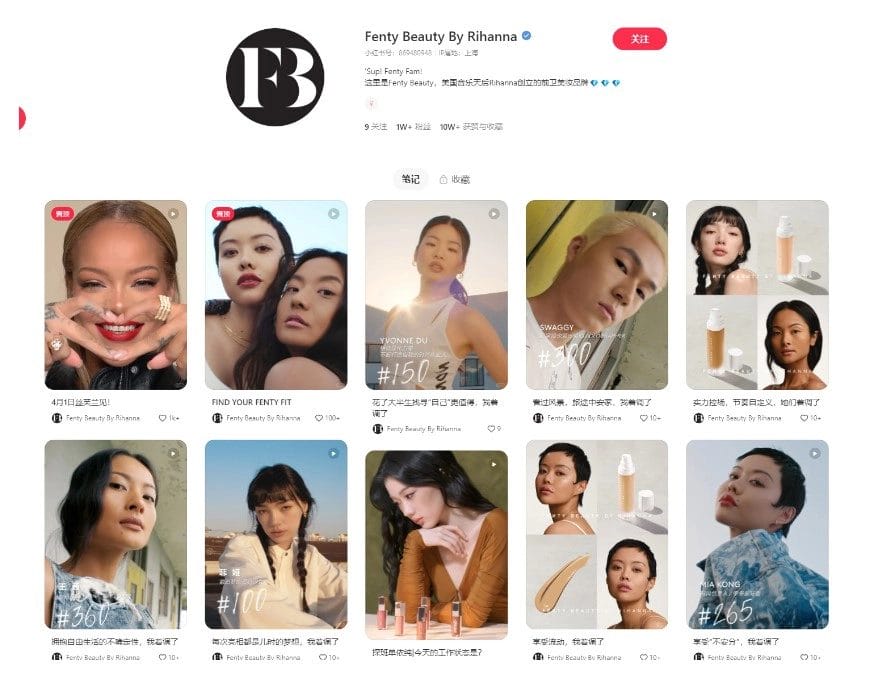
When Fenty Beauty entered the Chinese market in 2019, the line flopped. In the U.S., Fenty’s brand relies on cruelty-free messaging, diversity of shades, and Rihanna’s star power. Differences in animal testing rules, beauty standards, and media consumption meant the same strategy that hit with American audiences got a lukewarm reception overseas.
Fenty’s 2024 relaunch was full of lessons learned. Rihanna partnered with influencers on Douyin, created a pop-up shop, and referenced local memes in a public appearance.
Prioritizing the local makeup community made Chinese customers feel like Fenty is for them. The Douyin tag “Rihanna is in China” received over 4 million views.
How to Avoid Risks
- Do thorough market research: Learning about your customer is your top priority at this stage. Cult followings grow around products that meet customers’ needs and speak their language.
- Conduct focus groups and surveys: Use your networks to find makeup fans who can weigh in on your idea. If you’re a salon owner, your product distributor might have helpful insights. If you’re an esthetician, chat with clients and coworkers. Apps like SurveyMonkey and QuestionPro help you create shareable questionnaires.
- Scout online forums and social media: Big forums like Makeup Alley can provide a broad picture, but don’t neglect hashtags with fewer followers. Try niche groups like the sensitive skin forum Essential Day Spa or the Mature Beauty subreddit.
- Research existing products: Where does your target audience get their cosmetics, and what do their reviews reveal? Researching your competition pinpoints opportunities and minimizes the risk of investing in a product that already exists.
2. Plan & Finance Your Cosmetics Business
Starting a cosmetics line without a business plan is like doing your makeup for the first time without a tutorial. You have a pile of resources and an idea of where you want to end up, but no roadmap. A cosmetics business plan is just a structured way to break down your ideas, needs, and assets into realistic goals.
Follow these steps to create a convincing pitch for investors and organize ideas into a plan you can act on:
- Write brand vision and mission statements: Your vision statement explains the impact you want your product to have. A mission statement is a short but specific explanation of how you plan to make that vision happen.
- Outline your niche, customers, and competitors: You’ve already got this one covered! Put all that research to use and explain your product’s unique usefulness to your audience.
- Define your product line: Which products should you launch first? Start with a small but cohesive line that tells a clear story. If you’re new to handmade makeup and plan to DIY, start with the easiest homemade cosmetics and work up to specialized products.
- Set your manufacturing strategy: Will you create products from home, partner with a manufacturer, or apply your brand to existing products? The answer will depend on your timeframe, staffing, and scale.
- Consider where you’ll sell: Do you envision your product on social media, a business website, an online store, or in a nationwide retailer? Your brand positioning (mass market, mass prestige, premium, or luxury) should fit where you sell.
- Choose a funding strategy: Will you fund your own launch, seek investors, or take out a business loan? Planning for ongoing financing can keep you from scrambling for capital to fill orders if your line is a hit.
- Forecast your financial needs: If you’re magic with mascara but not a financial wizard, this is a good place to hire a professional. An accountant specializing in the beauty industry can chart realistic projections and plan for manufacturing and distribution needs.
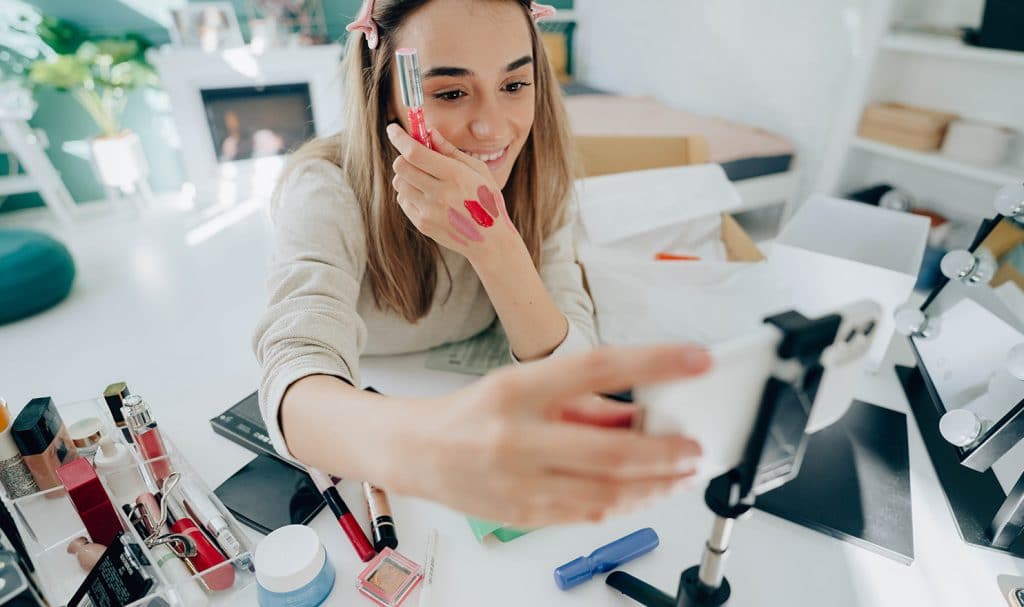
What Are the Risks?
Underestimating Resources
Misjudging the time, capital, and resources required to launch a makeup line can leave you with complicated and expensive scheduling or production challenges later.
Forrest is six months into his cosmetics startup when he has a chance to advertise through a top influencer. She needs the product now to fit her publishing calendar, but he isn’t sure he’ll be ready to distribute widely. He goes ahead. When orders come in, he can’t fill them and gets some bad press.
Cash Flow Challenges
Mismanagement of cash flow or lack of planning now makes covering daily operational costs and investments hard after your launch.
Kelsey is creating an innovative probiotic foundation. She didn’t budget enough to finish lab development, so she dips into her packaging budget. Luxe packaging is a must at her price point, so she borrows from the marketing budget. Her innovation needs to be explained to sell, so she uses distribution money. She ends up with a sought-after product, but no way to deliver.
How to Avoid Risks
- Don’t skip the business plan: Thinking through each stage of your launch will help you confront questions before you already have money invested.
- Stay realistic with your budget and timeline: Leave allowances for setbacks and consult with experts to decide how to start a cosmetic line with enough time and capital.
- Use tools and software to manage cash flow: You want to be profitable and stay in the good graces of any investors. Software like PlanGuru or QuickBooks can simplify bookkeeping, budgeting, and forecasting.
- Consider securing lines of credit for flexibility: If you’re asking people in your network to invest or financing through crowdfunding, consider talking to a bank to have a plan B. Individual investors can back out at the least convenient times.
What Are the Startup Costs for a Makeup Line?
Starting a makeup line business can cost $300, $50,000, or $1 million – it just depends on:
🌏 How big your business is: Making 10 eyeshadows for a local market booth is cheaper than producing 150 for a salon product distribution business, or 300–500 for an Amazon storefront. Do you want to be a side hustle, a small enterprise, or a global brand? Invest accordingly.
💄 How many products you launch: The more ingredients, testing, packaging, and marketing you need, the more you spend.
🚀 How fast you want to launch: Moving your product and getting ads in front of customers quickly requires a bigger budget than taking it slow and building a grassroots following.
✍️ How much you DIY: How much you pay depends on who’s doing the work (but so can the quality). Think about tasks you’re comfortable doing yourself at a high level. Structure your budget around areas where success requires specialized knowledge you can’t invest yourself.
🌐 Where you sell: Depending on your brand, selling through a retailer and using their existing audience may cost less than buying ads in the long run.
To estimate how much money you’ll need to invest, think through how you will price your product and what you want to spend on each of these cosmetic business startup costs:
Startup Task
Cost
Business registration
Registration only: $250+
Registration and incorporation: $350+
Beauty product liability insurance
$1,000/year+
Raw materials
$0.50–$1/unit
Packaging
$1–$3/unit
Labeling
DIY: $0.05+/unit
Professional: $500+ for creation and printing
Formulation
DIY: free
Chemist: $2,500/product on average
Testing
DIY: free (with research on existing tests)
Lab: $1,150+, allowing more for SPF tests
Filling and sealing
DIY: free
Professional: $0.15/unit–$1/unit
Professional website
DIY: $23+/month with Squarespace
Agency: $5,000+ on average
Marketing and branding
DIY using free tools: free or low-cost
Agency: $2,000+
Advertising
DIY paid social media ads: $300–$900/month
Agency: 5%+ of your total revenue
Distribution
Renting a market booth: $50+/event
Distributor: varies depending on volume, shipping model, etc.
2. Follow Legal & Regulation Guidelines
To launch a makeup line that doesn’t land you in legal trouble, you need to get your paperwork in order and understand the legal nuances around selling and advertising cosmetics in the U.S.
Along with registering your business and intellectual property, your biggest job at this stage is meeting Food and Drug Administration (FDA) cosmetic regulations.
What Are the Risks?
Intellectual Property Issues
Not securing trademarks, copyrights, or patents may leave you facing costly legal battles to protect your ideas or keep competitors from pretending to sell your products.
Jackie sees a dupe for her color-changing pH blush pop up on Amazon. Their product has the same packaging but doesn’t actually change color. Reviewers have started leaving negative comments on Jackie’s site, mistaking the dupe for her product. She didn’t trademark her branding, so there’s nothing Amazon can do.
Safety Risks
Challenges in developing or testing formulas that are safe, effective, and meet regulatory standards could lead to fines, lawsuits, and recalls.
Several customers have allergic reactions to Taylor’s eyeliner. Products that may touch the eye have extra-strict regulations he hadn’t taken into account. The FDA issues a recall, and he has to remove and dispose of all product from retail shelves, manufacturing, distribution, and warehouses. The cost almost bankrupts his small business.
Regulatory Risks
Failing to comply with local, national, or international cosmetic regulations can lead to legal penalties or a forced recall — removal of a product the FDA deems non-compliant from the market at your expense.
Risk Case Study:
Sephora and Target Clean Beauty Lawsuits
Recent Sephora and Target lawsuits for “clean beauty” claims show the problems a regulatory issue can cause for your brand, both financially and for your image.
Claims like “clean” and “natural” often fall into a gray area with the FDA, which is considering updating the cosmetics Green Guidelines to address consumer concerns. Regardless of whether you win in court, getting sued for makeup greenwashing is not a good look and can drive away customers.
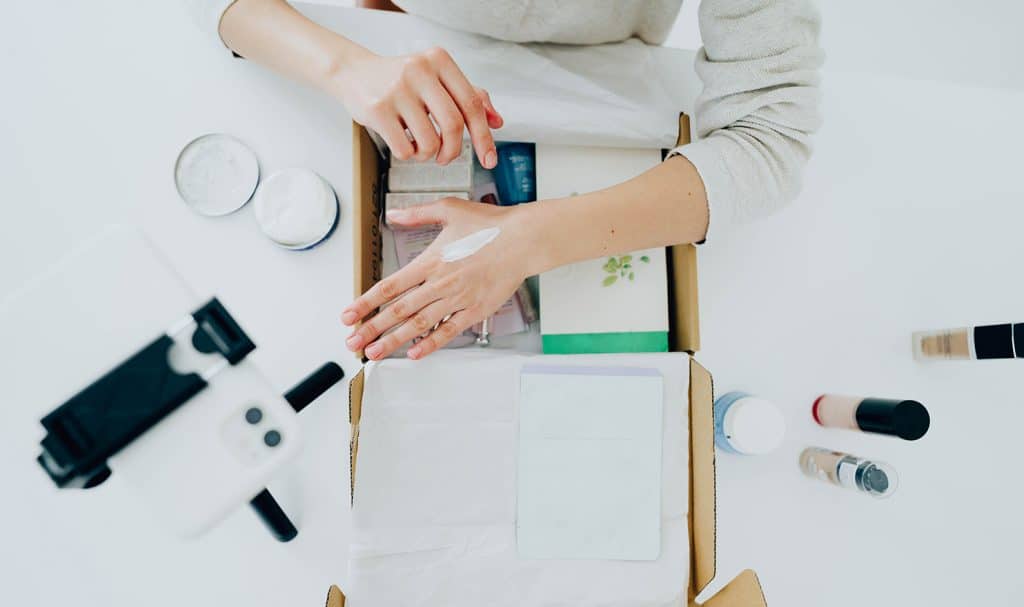
How To Avoid Risks
Register Your Business and Products
- Register your business with your state or local government. This usually involves at least getting a federal tax ID, a state business license, and incorporating as a limited liability company (LLC).
- Check your state cosmetics laws for local guidance.
- Register your cosmetics business with the FDA and renew every 2 years. Some small businesses are exempt, so check the FDA’s decision tool first.
- List all products and their ingredients with the FDA.
Meet Facility & Equipment Requirements
You’ll also need to meet FDA requirements outlined in their Good Manufacturing Practices (GMP) for facilities and equipment. If you own a home makeup business, the FDA small business and homemade cosmetic regulations outline rules that apply to you.
Follow Labeling, Packaging, and Advertising Claims Rules
- Ensure ingredients meet FDA organic cosmetics requirements to advertise as natural or organic.
- Follow FDA cosmetic labeling rules like disclosing ingredients and allergens.
Keep Up With Rule Changes
Check state and federal requirements regularly to avoid lawsuits and fees.
Consider a Trademark or Patent
Makeup dupes get complicated, but legal protections can help you avoid the worst pitfalls. Understanding the difference between trademarks vs patents can keep you covered for the risks you want to avoid:
- A trademark protects your brand identity and keeps other companies from posing as you.
- A patent protects the unique invention of a formula or product design from getting copied.
Get Insurance
Avoiding safety, health, legal, and advertising risks is an important part of how to start a makeup business, but even the best plans can go wrong when you sell hundreds, thousands, or even millions of units.
Makeup brands need product liability insurance designed to cover incidents like mislabelling, failure to provide warnings, advertising lawsuits, and claims due to health issues. If the expense of insurance is holding you back, learning what goes into the cost of product liability insurance can clarify what you’re getting and how to keep costs down.
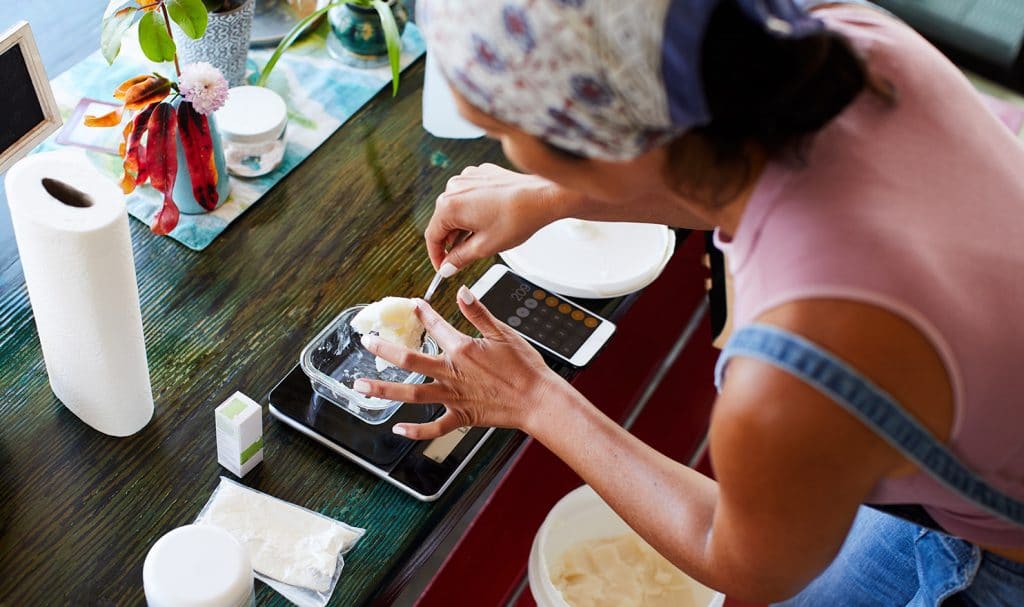
4. Make Your Cosmetics
All your planning and paperwork finally paid off – it’s manufacturing time. Deciding how to create your own makeup line depends on your budget and skills.
Should You Make, Manufacture, Private Label, White Label, or Wholesale?
Homemade Cosmetics
- What it means: Cosmetics that you create yourself from concept to filling orders
- Pros: Affordable, small-batch makeup creation with a high level of control
- Cons: You have to do everything yourself unless you want to hire help, from researching ingredients to finding makeup ingredient suppliers to mixing formulas.
- Good for: Microbusinesses and committed beginners. You may outgrow this model if you want to boost production or expand into products beyond your experience.
Who Does It Well:
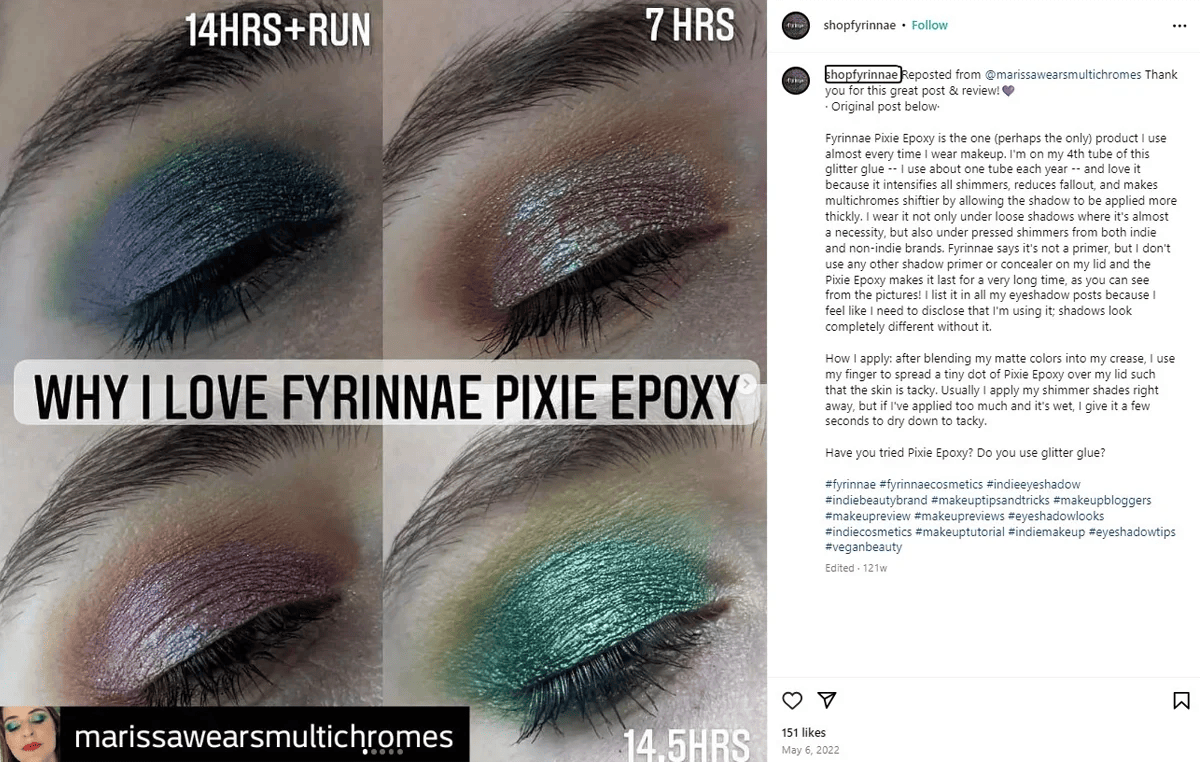
Known for unusual fragrances and duo- and multichrome eyeshadows, Fyrinnae has been a microbusiness with a macro impact for over 20 years.
For indie brands who start homemade and want to stay homemade, Fyrinnae is the perfect business model. Founded by cosmetic chemist Teir Connolly, the brand is a true cottage business with a team of three. Fyrinnae’s indie status is a big reason for its cult following, who like the exclusivity of a hyper-focused product line handmade in small quantities.
Contract Manufactured Cosmetics
- What it means: Cosmetics made by partnering with a lab or manufacturer that formulates and packages cosmetics based on your original product and specifications.
- Pros: Highly customized products produced at a high volume, plus the option to partner with chemists to refine and test formulas or expand your line.
- Cons: High customization means higher cost. You also order at least the minimum quantity in your contract, so a strong customer base and regular orders help forecast demand.
- Good for: Up-and-coming or established businesses where the product’s unique formula or performance is the draw. Price and order minimums can keep this from being an option for businesses without consistent demand.
Who Does It Well:
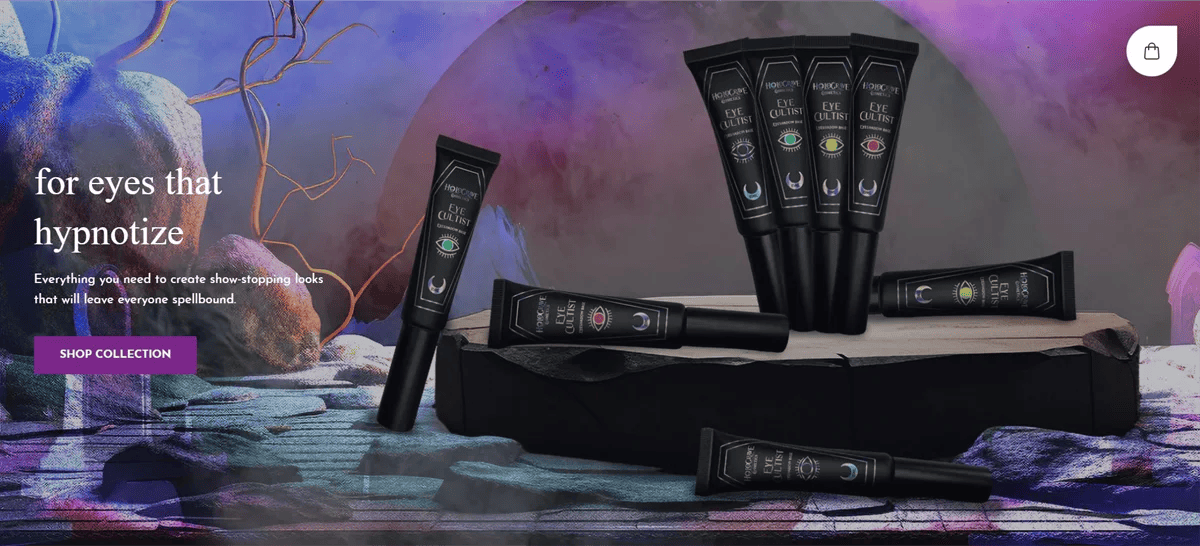
Mandy Crawford’s witchy indie brand emphasizes high customization with highly pigmented, mixable bases. The cosmetologist-owned brand started as a from-home business but moved to private manufacturing to keep up with demand while staying true to the brand’s vegan, cruelty-free, and talc-free roots.
Private Label Cosmetics
- What it means: Cosmetics formulated and manufactured by one company but created in partnership with a brand and sold under the brand’s name.
- Pros: Somewhat customized products produced at a high volume by experienced manufacturers. You can focus on concept, branding, marketing, and customer support, and let the manufacturer handle formula, testing, and production.
- Cons: Private labels often have a minimum order quantity, so there is less flexibility on cost. The lab that created the formula and design typically owns any patents.
- Good for: Businesses with consistent demand and a product that partially relies on branding or concept to engage customers. This is for you if you have a product idea but no formula or a branding concept that needs light customization.
Who Does It Well:
Hear us out. Yes, the similarity of these brands manufactured by Spatz Labs caused controversy in the mid-2010s. But they became the example of private label manufacturing because this method was a great fit for each brand.
ColourPop founders and Spatz Labs owners Laura and John Nelson also do brand mentoring and private label work. They get extra revenue and similarity to a luxe product doesn’t hurt ColourPop, which markets itself as a trendy, luxury-quality product for less.
Private label was also a good fit for Kylie Jenner (famously not a chemist). She developed trend-setting shades, marketed to her followers, and put her branding on a customized, luxe formula she sold at luxury prices. Because her concept was a little about formula and a lot about branding, it worked perfectly.
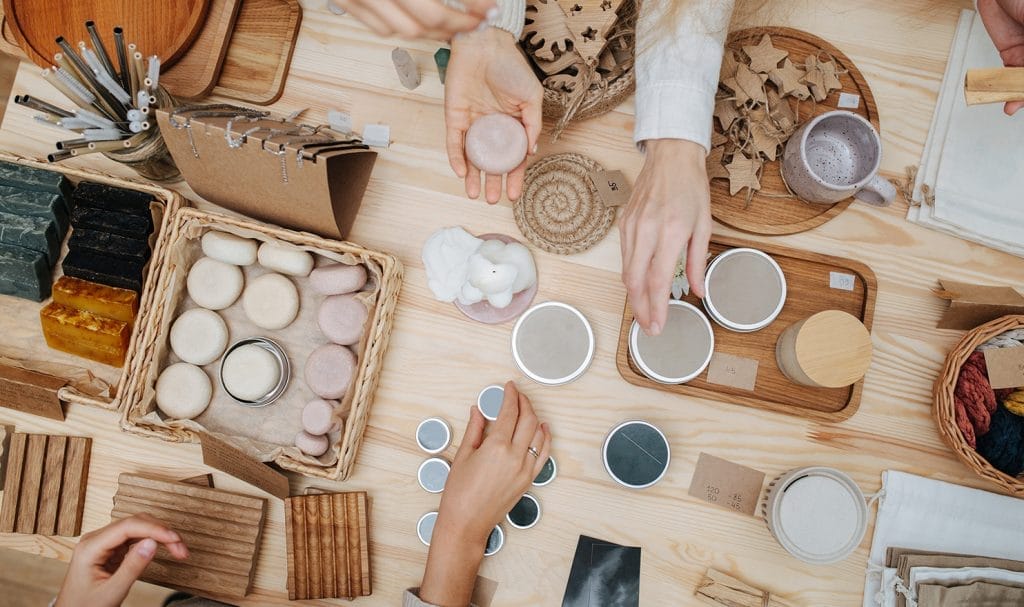
White Label Cosmetics
- What it means: Buying the (non-exclusive) right to sell cosmetics formulated and manufactured by another company under your name.
- Pros: Inexpensive, ready-to-label products made with ingredients and formulas already tested for FDA regulations by the manufacturer. This route offers minimum risk for you at the compliance and manufacturing stages plus products you can stock and ship quickly.
- Cons: White label products offer almost no customization, so you sell the same product as many other companies. This means no marketing claims about the uniqueness of your product’s performance or formula.
- Good for: Product ideas where branding is the draw.
White label products typically don’t like to out themselves, but they’re much more common than you might think. The white label cosmetics market is worth an estimated $1 billion in 2024.
Say you want a natural beauty makeup line for your spa. A white label product is easy to restock with a high profit margin. Just pick natural shades from the manufacturer menu and give them evocative names that fit your branding. If the generic product is high quality, a one-stop beauty experience and spa-branded packaging give your product its unique value.
What Are the Risks?
Supplier Reliability
Unreliable suppliers may delay shipments of ingredients, packaging, or labels, causing extra expense and order fulfillment problems. A bad manufacturer can also create low-quality products or further delays due to miscommunication.
Chloe has had nothing but problems with her manufacturer. First, the product packaging was not what they agreed on, and then the color formulation was off, causing complaints about inconsistency. She’s behind on her distribution schedule and will get further behind if she has to start over with another manufacturer.
Cost Overruns
Going over budget now strains your finances, leaving less for production and marketing later.
Peyton signed a contract for more than they really wanted to spend with the lab. The formula looks amazing, but they’re going to have to halt production and ask their Go Fund Me patrons for more money to deliver the quirky packaging promised in the funding campaign.
How to Avoid Risks
- Partner with reputable and certified labs, suppliers, and manufacturers: If you’re leaving developing, testing, or creating products in someone else’s hands, you need to be able to trust them. Do your research to choose the right cosmetics manufacturer and don’t settle for the company with the lowest price.
- Establish strong manufacturer and supplier contracts: Get clear expectations in writing for how much product you will order, timelines, and services you will pay for. Understanding your manufacturer’s minimum order quantity (MOQ) will help you anticipate costs.
- Have a backup list of vetted suppliers to avoid disruptions: If your supplier or manufacturer doesn’t work out, it’s helpful to have other options ready to avoid delays. A cosmetics manufacturer directory is a good place to start your research.
- Keep track of expenses and expect the unexpected: It’s safe to assume something won’t go perfectly. Plan for extra costs and do regular spending audits to keep the budget on track.
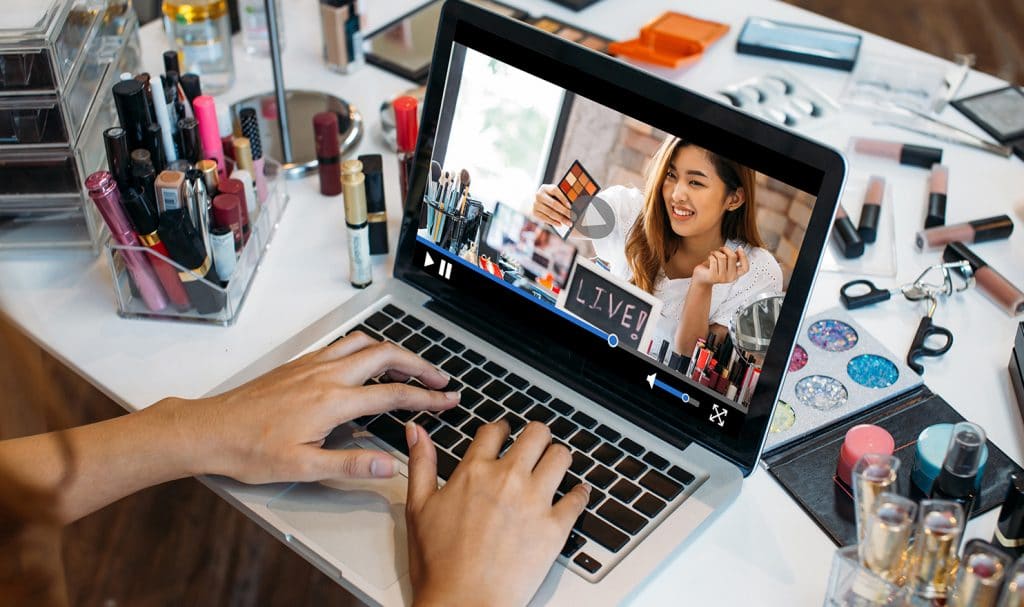
5. Brand & Market Your Line
Time to give your product a voice – and start communicating with your customers. The branding of your product involves everything from your company, product, and shade names to your logo, package design, and online presence.
Creating a consistent brand means telling a cohesive story across all channels that fits your niche and highlights your unique value. These brands take different marketing approaches but both nail the final look.
How To Do It Well
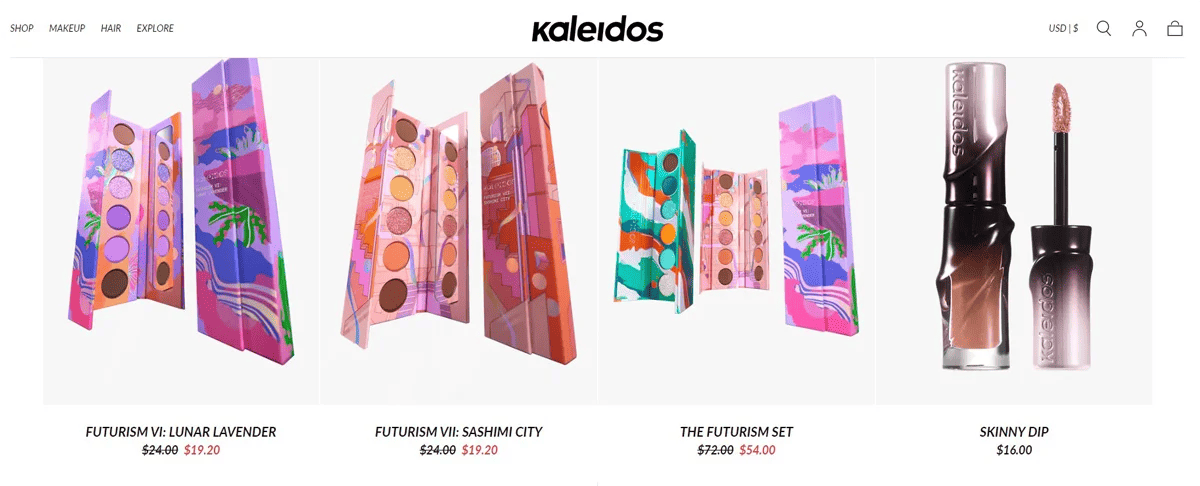
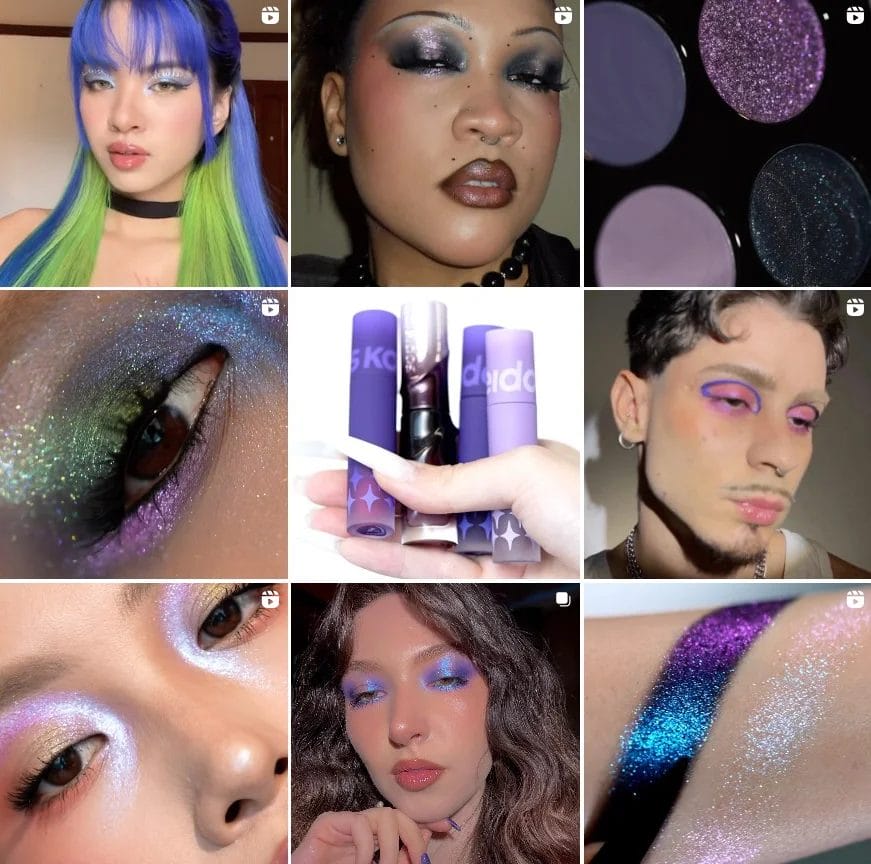
Indie brand Kaleidos uses finishes, shades, and textures outside of the mainstream to represent the kaleidoscopic, evolving nature of beauty. Imaginative packaging and fantastical or cheeky shade names fit its core values of individuality, authenticity, and eccentricity.
Kaleidos’ social media feeds don’t have a salesy gimmick in sight. Instead, they overflow with followers’ reposted alternative makeup looks to celebrate diverse beauty and creativity. The effect is bold, rebellious, and community-driven – just right for its audience.
How To Do It Well
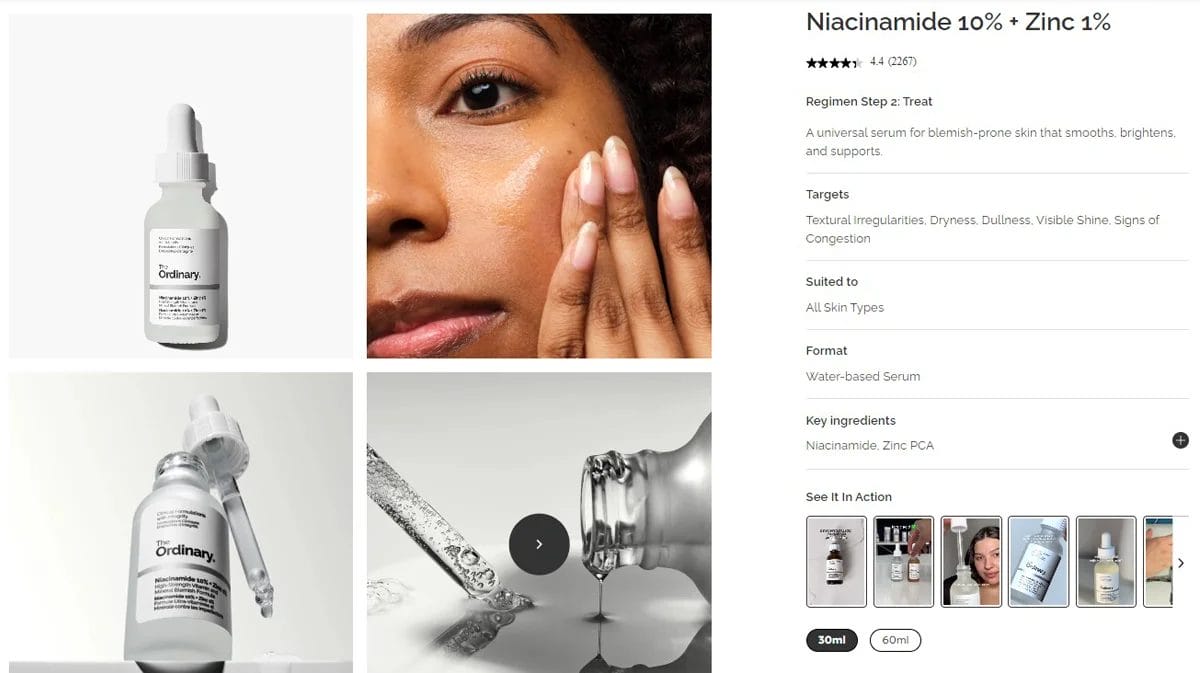
When competitors pile on luxe ingredients and lush visuals, plainness feels disruptive. The Ordinary translates no-fuss, low-ingredient skincare and cosmetics into simple branding that stands out because it’s simple.
A black-and-white text logo and straightforward packaging put function and ingredient transparency front and center. Neutral, pared-back imagery and product pages cut straight to the essentials this customer wants – the product, what it does, and how you know.
Inspired to start imagining your brand? Start your marketing efforts with the most important places customers meet your brand: your professional website and social media platforms. Here are a few ideas:
- Add testimonials or reviews to your website
- Make your site more visible to searchers with search engine optimization
- Customize your product packaging to be photo-worthy
- Share your causes and create advocacy-centered partnerships
- Organize and plan your social media posts
- Run social media ads
- Show off your creation process in social media posts
- Repost fans using your products
- Reach out to micro-influencers
- Collaborate with local businesses like spas and hotels
- Run social media challenges to get user-generated content
What Are the Risks?
Brand Perception
Ineffective marketing or public relations mishaps can damage your brand’s customer relationship.
It’s a disaster. The Facebook ad campaign for Brock’s inclusive concealer line left off the final slide showcasing shades for deep skin tones. Inclusivity is the cornerstone of his brand, so the ad was blasted across social media before Brock noticed the mistake.
Market Competition
Trouble differentiating your product in a saturated market can make finding and keeping customers tough.
Karie’s entire marketing strategy was based around the novelty of her highlighter sunscreen stick – until production challenges slowed down the launch and someone else got there first. Now her advertising sounds like just another imitator of a new trend.
How to Avoid Risks
- Develop a strong brand strategy that resonates with your audience: Hitting on the right approach takes time and research. You can do the graphic design using sites like Canva, or hire a freelance branding specialist if marketing isn’t your thing.
- Use focus groups for risky ads or new marketing strategies: If you’re unsure how customers will respond to an advertising approach, run it by a focus group. That might mean formal conversations, an email survey, or informally asking within your network.
- Follow through on your values: Keep customer goodwill and avoid false advertising lawsuits by acting on the causes you say you value. Offer transparency on charitable giving and promises about ingredients, testing methods, or sustainability.
- Keep a close eye on industry trends and competitor activities: Be prepared to pivot when trends change or competitors start moving into your niche to stay relevant.

6. Find Your Distributor
So where will you sell your freshly branded makeup and how do you get it to customers? DIY distribution from home, local craft fairs, or an existing storefront like a salon is an option if your makeup line business is small. To grow your customer base, you may need to outsource parts of the sale, boxing, and shipping process.
These are your main distribution options:
Direct to Consumer (DTC)
A brand website or social media platform that lets customers buy directly from you can cut out a link or two in the supply chain. You still need to box and ship your products or hire a third-party logistics company, but your biggest hurdle at first will be helping customers find you. Try ads on social media, Google shopping, or search engines to promote a DTC site.
E-commerce Marketplaces
Selling on Amazon, Etsy, eBay, and other online platforms solves the problem of building an audience by putting you in front of another site’s customers. Note: marketplaces have rules about what you can sell or advertise and may charge account fees.
Wholesalers
Wholesalers can get your product in front of new audiences by buying in bulk from you or your manufacturer and selling to retailers. To find a wholesale distributor, start with your contacts. Your manufacturer may sell to you directly or provide a list of vetted distributors.
Subscription Boxes
You can also look into getting placed in subscription boxes. This works well if your product fills a recurring need. Earn a spot in a box (and an intro to new customers) by contacting subscription box businesses like Birchbox to learn their requirements.
What Are the Risks?
Distribution Hurdles
Not establishing effective distribution channels can limit your market reach and affect sales. requirements.
Parker wants to expand his homemade makeup line beyond the local scene. He only sells in craft markets, and as he places in events further away, the transportation and time requirements are eating into his profits.
Retail Partnership Risks
Dependence on retail partners can leave you in a lurch when they don’t pan out or result in unfavorable terms for your business profits.
Marcie was floored to get an exclusive distribution deal with Walmart, but they requested changes to packaging and a lower price point that she hadn’t budgeted for. Marcie’s business is small and margins are tight. She ends up not selling as much as expected and barely breaks even.
How to Avoid Risks
- Diversify your distribution. If Amazon penalizes your store for being out of stock, does your business shut down? Look into options like a personal website or social media marketplaces along with retail partners, subscription boxes, and wholesale.
- Build relationships with more than one retailer. Negotiate contracts that don’t rely on selling exclusively to one retailer.
- Consider adding distribution partners as additional insureds (other people and companies covered by your product liability policy). Many distributors require it in their contracts, but being prepared and reducing risks across the supply chain makes you a great partner.
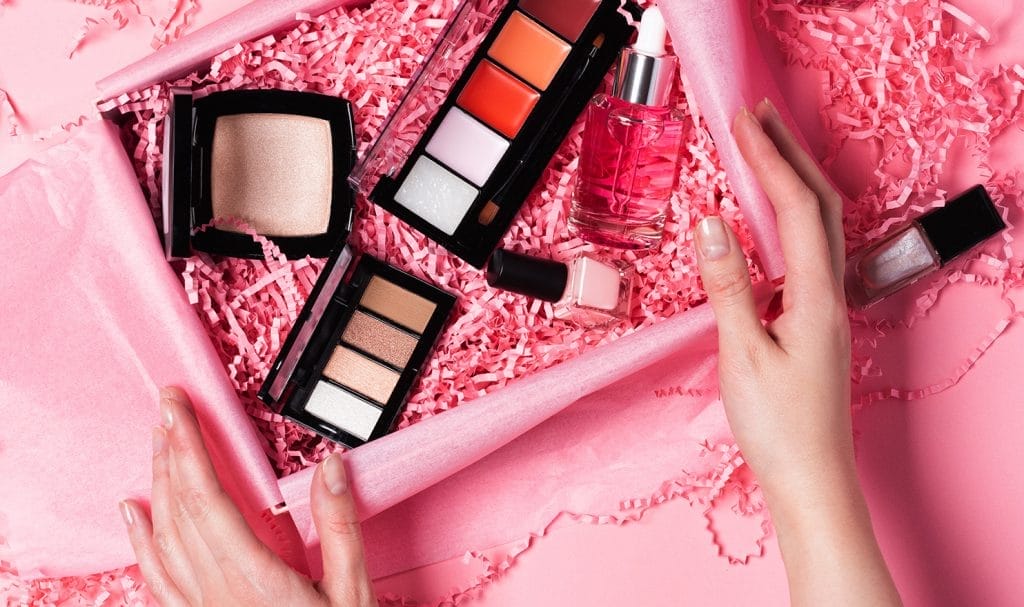
Next Steps: How to Expand Your Makeup Line As Your Business Grows
So you’ve had a successful launch and orders have started pouring in – now what? Building a strategy that’s sustainable beyond the start of your line will prepare you for a business glow-up rather than growing pains.
Think ahead to long-term success with these steps for growing a cosmetics line:
- Expand your customer base: Who else might be interested in your product? Can you invite more customers in without alienating your niche?
- Grow brand recognition: Brainstorm ways to get your name in front of new clients, such as pitching your brand to Sephora or starting a blog, like Glossier.
- Offer more products: Poll your customers to ensure new products still fulfill the needs in your niche.
- Streamline your process: What have you learned from the launch that you could apply to optimize your supply chain? Where could you improve efficiency or cut costs?
- Cultivate loyalty: Now that you have found your people, keep them engaged with loyalty programs, discounts, and listening sessions to stay connected to their needs.
Want to keep building your foundation of product knowledge? Learn from a beauty industry insider which ingredients, claims, and products most insurers won’t cover.
How to Start a Makeup Business FAQs
Is Starting a Makeup Line Profitable?
Do I Need Insurance to Start a Makeup Line?
Yes! All makeup brands need product liability insurance, even though it’s not a state or federal requirement. The risk baked into each stage of how to sell makeup online means you’ll have a hard time finding a manufacturing or retail partner if you’re uninsured.
What Kind of Insurance Do I Need to Start a Cosmetics Line?
Makeup line creators should look into these types of insurance to cover their risks:
- Beauty and cosmetic product liability insurance: Product liability insurance specialized to the beauty industry is designed to protect your business financially in case of mislabelling, defects, intellectual property lawsuits, and other incidents.
- Handmade beauty products insurance: If you DIY your products at home, you may want to choose a product insurance policy designed specifically for handcrafters to avoid coverages you don’t need and keep your costs down.
- Product recall insurance: Between lost revenue, lawsuits, delays, stocking fees, and disposal costs, recalls can be a financial game over for small businesses. Insurance Canopy offers product recall insurance as an add-on to your cosmetics insurance, making it easier to bounce back in the event of a recall.
- Tools and equipment coverage (Inland marine): A must for importers, this insurance add-on can cover damages to your products or equipment during transportation over land.
- Cyber liability insurance: If you collect personal information like names, contact info, and credit card numbers, you could face a hefty lawsuit if you fall victim to a data breach or cyberattack. Cyber liability insurance is made to cover legal fees to protect your business if the worst happens.
What Risks Do Cosmetic Manufacturers Face?
Makeup manufacturers can be responsible for medical expenses due to contaminated products, legal fees, product recalls, workers’ compensation, equipment costs, and more if something goes wrong. Manufacturing insurance keeps your risks manageable with coverages for the product liabilities you face.

JoAnne Hammer | Program Manager
JoAnne Hammer is the Program Manager for Insurance Canopy. She has held the prestigious Certified Insurance Counselor (CIC) designation since July 2004.
JoAnne understands that starting and operating a business takes a tremendous amount of time, dedication, and financial resources. She believes that insurance is the single best way to protect your investment, business, and personal assets.
JoAnne Hammer is the Program Manager for Insurance Canopy. She has held the prestigious Certified Insurance Counselor (CIC) designation since July 2004.
JoAnne understands that starting and operating a business takes a tremendous amount of time, dedication, and financial resources. She believes that insurance is the single best way to protect your investment, business, and personal assets.

